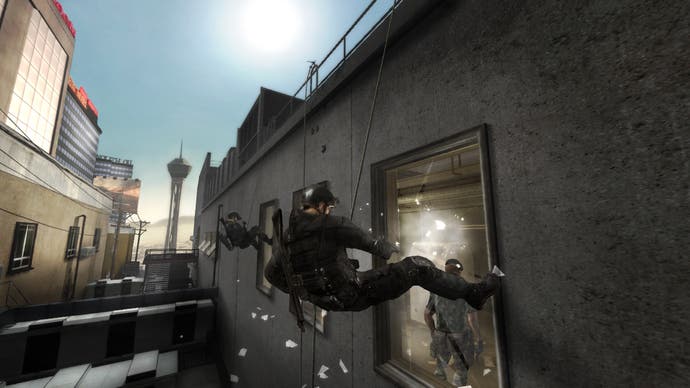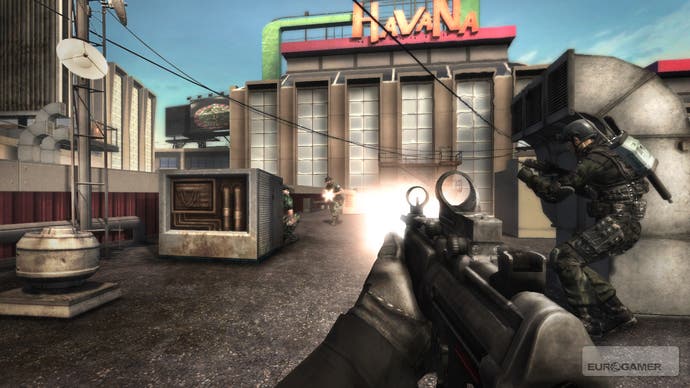Tom Clancy's Rainbow Six: Vegas 2
Hat-trick for violet.
It's all, says Therien, down to a basic desire to make Rainbow Six more accessible - not by cutting out the tactical element of the game, but by making it easier for new players to understand how the tactical aspects actually work.
"We like the fact that the Clancy games are more tactical," he tells Eurogamer. "We like the fact that Rainbow is a smart shooter. We like the pace, we like the fact that it sets itself apart. Now, it's a bit less accessible than other games, like Call of Duty for example, so what we're aiming to do with stuff like the ACES system is to show people that tactical gameplay doesn't mean hardcore, and it doesn't mean complicated. It doesn't mean that it has to be a very daunting system.
"We're hoping that people will be able to familiarise themselves a little bit more with what 'tactical' is, and actually come to learn what the whole Rainbow Six thing is all about - like what CQB means, what being a marksman is, the difference between assault and infiltration. We're hoping that that will help people figure that out."
Close Encounters

Wrapping all of these gameplay tweaks up into a neat package are some overhauled multiplayer modes (there's an adversarial multiplayer vid on EGTV) and a fresh single-player campaign - with the single-player experience in particular being a focus for the team. The first Vegas had a rather good story mode, and, as Therien readily admits, "it really surprised people that Rainbow Six was shipping with a solid single-player."
The bar was set. "We knew that we had to do the same, if not better, on the single-player for Vegas 2." The team was also clear on where it wanted to go next - right back to Las Vegas, where it had unfinished business.
"Vegas wasn't done," Therien says, bluntly. "When you finished Rainbow Six: Vegas, that wasn't over - everybody knew that. There was a big, giant To Be Continued. We put confusion there on purpose, because we knew we wanted to keep going.
"This time, since we had more time to work on content, we made a beginning for the story. Then there's the parallel section with Vegas 1, and then more happens after the ending of Vegas 1. The story is better explained, and it's finished in a very satisfying way."

The storytelling itself is better, too. The Montreal team has learned from the tricks being employed by other shooters in recent years, and has dropped its old approach of doing all the storytelling in-between levels in favour of more in-level, interactive storytelling. Little story vignettes will reveal themselves through the design of the levels you play through, and the levels themselves will feel more connected to one another - and to the story.
Multiplayer, too, has had a facelift (of which more in a dev-diary on Eurogamer TV). The team was largely happy with the multiplayer modes in the first Vegas, says Therien, "but at the same time, we didn't just want to sit on it and say, here are some new maps, now go and enjoy the same game you've already been playing." As such, the wheel hasn't been reinvented - but along with the new basic gameplay features and the ACES system, multiplayer is also being reinvigorated with a few new modes.
Team Leader is a particularly tense variation on the VIP modes in many other shooters - each team has a designated leader, whom they have to escort to the extraction point on the other side of the map while trying to kill the enemy's leader. In Vegas 2's take on the mode, though, your team-mates can respawn while your leader is alive - and even once he's dead, you don't lose the match until the enemy leader is extracted, or all your team-mates are eliminated. The mode depends heavily on communication, too, because the team leaders can actually see one another on their mini-maps.





.png?width=291&height=164&fit=crop&quality=80&format=jpg&auto=webp)



